Restaurant Seating Layout Design: Complete Planning Guide

Why Restaurant Seating Layout Matters for Your Success
The seating layout you choose impacts everything from customer satisfaction to your bottom line. A well-designed restaurant seating arrangement can increase table turnover by 20-30%, improve customer experience, and ensure ADA compliance. This comprehensive guide will walk you through every aspect of designing the perfect restaurant seating layout.
Key Benefits:
- Revenue Optimization: Maximize seating capacity and turnover rates
- ADA Compliance: Meet all accessibility requirements
- Operational Efficiency: Streamline server traffic and kitchen flow
- Customer Satisfaction: Create comfortable, inviting dining experiences
Step 1: Planning Fundamentals - Space Analysis & Regulations
Calculate Your Space Utilization
Before purchasing any furniture, analyze your available space:
- Total Square Footage: Measure dining area, minus kitchen, restrooms, and storage
- Seating Capacity: 18-20 square feet per person (minimum requirement)
- Revenue per Square Foot: Target $150-300+ annually per square foot
- Traffic Flow: Ensure 36" ADA-compliant aisles and 18" standard pathways
ADA Compliance Requirements
ADA regulations require:
- 5% of seating must be wheelchair accessible (minimum)
- 36" wide aisles for wheelchair navigation
- 30" x 48" table clearance under accessible tables
- Knee clearance of 27" high x 30" wide under tables
Pro Tip: Consult local authorities for specific ADA requirements. Use our ADA Regulations Guide for detailed compliance information.
Profitability Considerations
- Table Turnover: Design for 45-90 minute average dining time
- Party Size Mix: 40% two-tops, 30% four-tops, 20% six-tops, 10% larger parties
- Peak Hour Capacity: Ensure 80% utilization during busy periods
- Seasonal Adjustments: Flexible layouts for different crowd sizes
Ensure efficiency and profitability
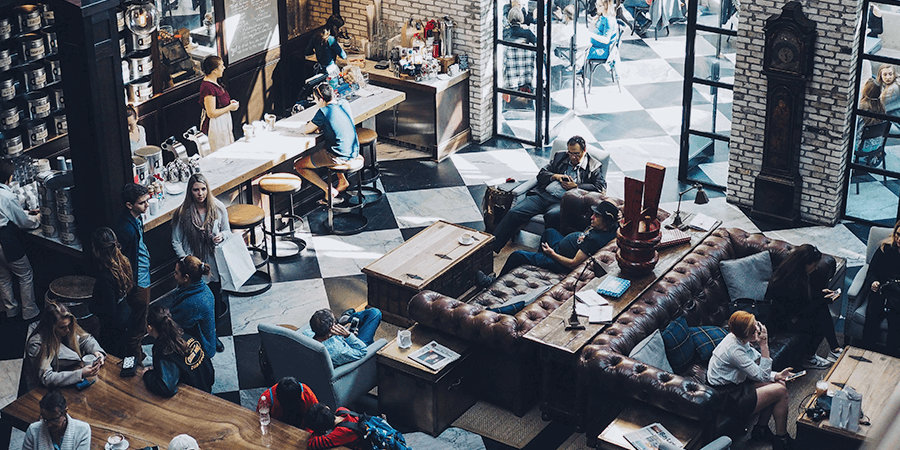
Step 2: Understanding Restaurant Types & Their Seating Needs
Fine Dining Restaurants
Characteristics: Formal atmosphere, longer dining times, higher check averages
Seating Strategy:
- Booths: 60% for privacy and comfort
- Tables: Mix of 2-tops and 4-tops for couples and small groups
- Spacing: Minimum 18" between tables for service access
Casual Dining Restaurants
Characteristics: Family-friendly, moderate prices, faster turnover
Seating Strategy:
- Flexible Tables: 70% movable for party size adjustments
- Booths: 20% along walls for families
- Bar Seating: 10% for walk-ins and quick service
Fast Casual & Quick Service
Characteristics: Counter service, limited seating, fast turnover
Seating Strategy:
- Community Tables: Encourage social interaction
- Bar Seating: High-top tables for quick meals
- Outdoor Seating: Maximize available space
Specialty Restaurants (Bars, Cafes, Food Halls)
Characteristics: Ambiance-focused, extended hours, social gathering
Seating Strategy:
- Lounge Seating: Comfortable for extended stays
- Standing Height Tables: 42" for casual dining
- Mixed Heights: Create visual interest and accommodate different group sizes
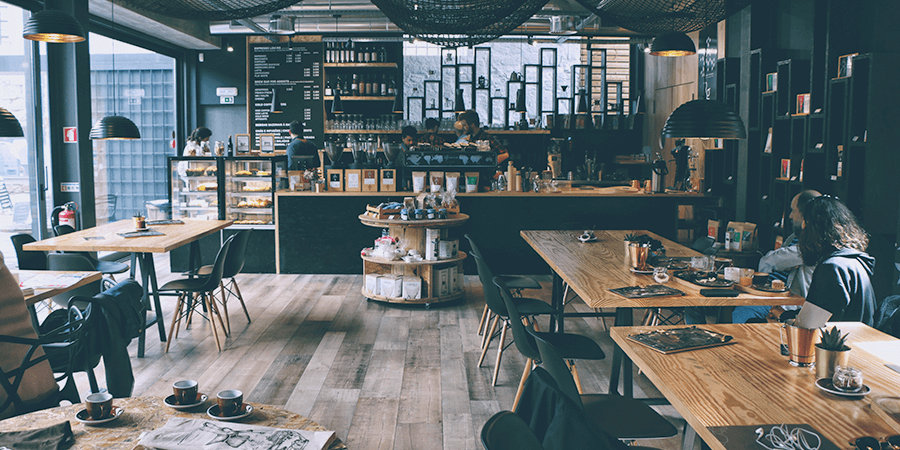
Step 3: Seating Types & Material Selection Guide
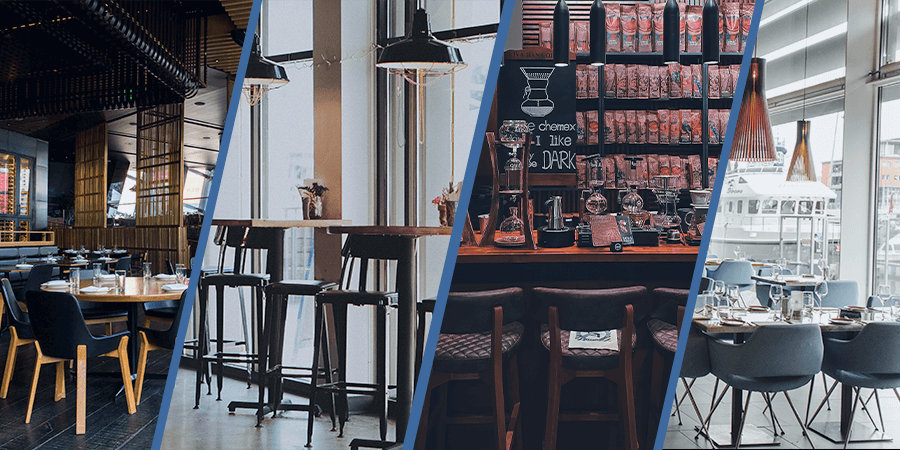
Commercial Seating Options
1. Anchored Booths
Best For: Fine dining, family restaurants, privacy-focused establishments
Pros:
- Maximum legroom and comfort
- Sound dampening for conversation
- Space efficient (no chair storage needed)
- Creates private dining experience
Cons:
- Fixed positioning limits flexibility
- Higher cost per seat
- Difficult wheelchair access (requires ADA modifications)
Cost Range: $800-2,500 per linear foot
Maintenance: Clean upholstery regularly, replace cushions every 3-5 years
2. Portable Chairs & Tables
Best For: Casual dining, fast turnover, flexible party sizes
Pros:
- Easy rearrangement for different party sizes
- Cost-effective for large seating areas
- Better ADA accessibility
- Faster table turnover
Cons:
- Less legroom than booths
- Chairs can be unstable or break
- Storage space required when not in use
Cost Range: $200-600 per chair, $300-800 per table
Maintenance: Metal frames require rust protection, fabric needs regular cleaning
3. Bar & Counter Seating
Best For: Bars, casual dining, waiting areas, walk-in traffic
Pros:
- Maximizes space utilization
- Encourages social interaction
- Perfect for solo diners and quick service
- Lower cost per seat
Cons:
- Limited to certain customer types (not ideal for families with children)
- Less comfortable for extended dining
- Can create noise issues
Cost Range: $150-400 per stool
Maintenance: Metal surfaces need polishing, upholstery requires cleaning
Material Selection Matrix
| Material | Durability | Comfort | Cost | Best For | Maintenance |
| Wood: | High | High | High | Fine dining | Polish regularly |
| Metal: | Very High | Medium | Medium | Casual/fast casual | Rust protection |
| Upholstered Fabric: | Medium | Very High | High | Upscale casual | Professional cleaning |
| Plastic/Vinyl: | High | Medium | Low | Family/kids | Easy wipe-down |
| Leather: | High | High | Very High | Premium dining | Condition regularly |
Pro Tip: Always choose commercial-grade furniture rated for 1,000+ uses per day. Look for warranties of 5+ years.
Step 4: Layout Strategies & Configurations
Basic Layout Types
1. Linear Layout
- Description: Tables arranged in straight rows perpendicular to walls
- Best For: Banquet halls, large parties, buffet-style service
- Space Efficiency: High (85-90% utilization)
- Traffic Flow: Good for one-way service patterns
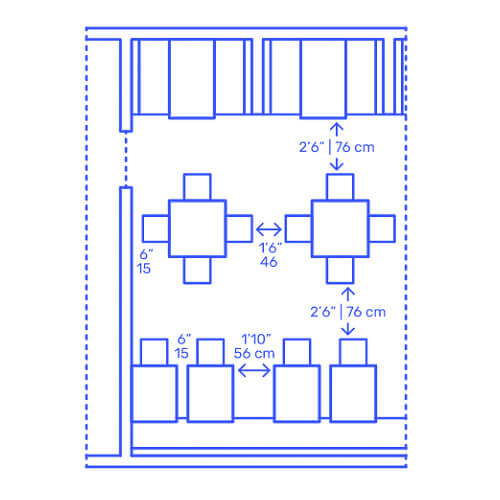
2. Cluster Layout
- Description: Tables grouped in pods of 4-6 tables
- Best For: Casual dining, conversation-focused restaurants
- Space Efficiency: Medium (75-80% utilization)
- Traffic Flow: Allows multiple service stations
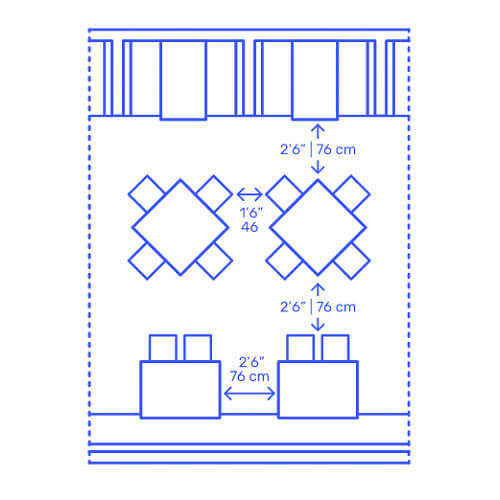
3. Free-Flow Layout
- Description: Organic arrangement without strict rows
- Best For: Fine dining, creative restaurants, irregular spaces
- Space Efficiency: Medium (70-75% utilization)
- Traffic Flow: Flexible but can create congestion
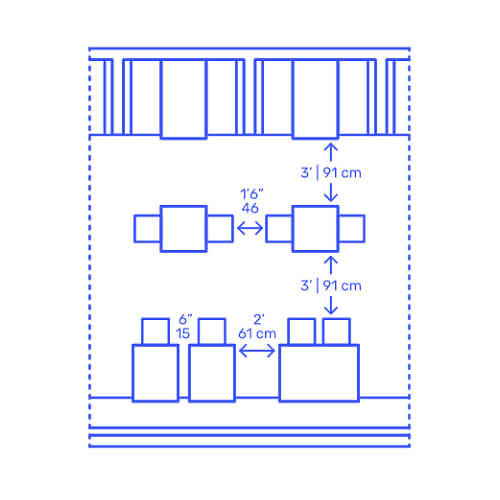
4. Booth-Dominant Layout
- Description: Majority of seating in fixed booths along walls
- Best For: Family restaurants, comfort-focused dining
- Space Efficiency: Medium-High (80-85% utilization)
- Traffic Flow: Clear pathways but limited flexibility
Advanced Layout Considerations
Server Station Placement
- Central Location: For quick-service restaurants
- Perimeter Placement: For fine dining (less intrusive)
- Multiple Stations: For large restaurants (reduce wait times)
Traffic Flow Optimization
- Main Aisles: 48-60" wide for primary pathways
- Service Aisles: 36" wide minimum for server access
- Emergency Exits: Clear, unobstructed paths to exits
- Kitchen Access: Direct pathways from kitchen to dining area
Multi-Room Considerations
- Sound Control: Separate areas for different noise levels
- Capacity Management: Ability to close/open sections based on demand
- Staff Coordination: Clear communication between room captains
Step 5: Budget Planning & ROI Calculations
Cost Breakdown by Seating Type
| Seating Type | Cost per Seat | Installation | Annual Maintenance | Expected Lifespan |
| Booths: | $1,200 - 2,800 | $200 - 500 | $50 - 100 | 10 - 15 years |
| Tables/Chairs: | $400 - 1,000 | $50 - 100 | $20 - 40 | 5 - 10 years |
| Bar Stools: | $250 - 600 | $25 - 50 | $15 - 30 | 7 - 12 years |
| Banquettes: | $800 - 1,500/linear ft | $150 - 300 | $40 - 80 | 12 - 18 years |
5-Year ROI Analysis
Assumptions:
- Average check: $45
- Daily covers: 150
- Operating days: 300/year
- Annual revenue: $2,025,000
- Seating cost: $75,000
ROI Calculation:
- Year 1 Revenue Increase: 15% ($303,750 additional revenue)
- Net Profit Increase: $121,500 (40% margin)
- ROI: 162% in first year
- Payback Period: 7.4 months
Financing Options
- Equipment Leasing: 24-60 month terms, 0% interest options
- SBA Loans: Government-backed financing up to $5.8 million
- Restaurant Equipment Financing: Specialized lenders for hospitality
- Tax Incentives: Section 179 deduction for equipment purchases
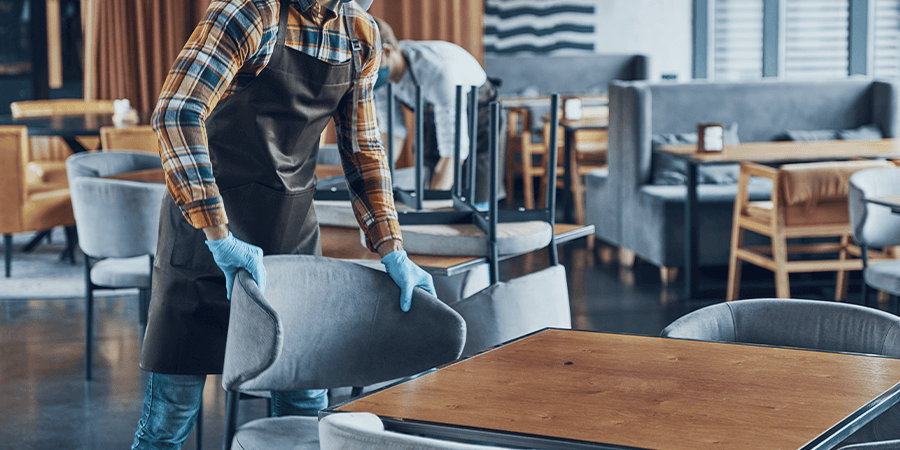
Step 6: Implementation Timeline & Execution
8-Week Planning Timeline
Weeks 1-2: Planning & Design
- Space measurement and analysis
- ADA compliance review
- Budget allocation and financing
- Preliminary layout sketches
Weeks 3-4: Supplier Selection
- Research commercial furniture suppliers
- Request quotes and samples
- Review warranties and delivery terms
- Finalize material selections
Weeks 5-6: Ordering & Installation
- Place orders with 4-6 week lead time
- Coordinate delivery and installation
- Test furniture placement and comfort
- Make adjustments as needed
Weeks 7-8: Testing & Training
- Staff training on layout and service flow
- Pre-opening test runs
- Customer feedback sessions
- Final adjustments and refinements
Supplier Coordination Tips
- Lead Time: Plan 6-8 weeks for custom orders
- Samples: Always test furniture comfort before ordering
- Installation: Professional installation prevents damage
- Warranties: Compare coverage and replacement policies
Step 7: Common Mistakes & How to Avoid Them
Top 10 Layout Mistakes
1. Ignoring Traffic Flow
- Problem: Servers and customers constantly bump into each other
- Solution: Map out all movement patterns before finalizing layout
- Cost of Mistake: 15-20% reduction in service efficiency
2. Overcrowding Tables
- Problem: Customers feel uncomfortable and leave quickly
- Solution: Maintain minimum 18" between table edges
- Cost of Mistake: Reduced check averages and customer loyalty
3. Poor ADA Compliance
- Problem: Legal issues and accessibility barriers
- Solution: Designate 5%+ of tables as ADA compliant
- Cost of Mistake: Fines up to $75,000 per violation
4. Inconsistent Seating Heights
- Problem: Uncomfortable dining experience
- Solution: Standardize table heights within seating areas
- Cost of Mistake: Negative reviews and lower return rates
5. Blocking Emergency Exits
- Problem: Safety violations and code compliance issues
- Solution: Keep 36" clear pathways to all exits
- Cost of Mistake: Failed inspections and closure risks
6. Poor Server Station Placement
- Problem: Increased wait times and frustrated staff
- Solution: Position stations for optimal kitchen-to-table flow
- Cost of Mistake: 20-30% increase in customer wait times
7. Ignoring Acoustics
- Problem: Excessive noise reduces dining enjoyment
- Solution: Use booths and acoustic panels strategically
- Cost of Mistake: 25% drop in customer satisfaction scores
8. Seasonal Capacity Issues
- Problem: Too crowded in peak seasons, too empty off-peak.
- Solution: Design flexible layouts with movable furniture
- Cost of Mistake: Lost revenue during peak periods
9. Poor Material Selection
- Problem: High maintenance costs and short furniture lifespan
- Solution: Choose commercial-grade materials rated for heavy use
- Cost of Mistake: 2-3x replacement costs over 5 years
10. Lack of Staff Input
- Problem: Layout doesn't work for actual operations
- Solution: Include servers and managers in design process
- Cost of Mistake: Ongoing operational inefficiencies
Step 8: Measuring Success & Ongoing Optimization
Key Performance Indicators (KPIs)
Financial Metrics
- Revenue per Square Foot: Target $150-300 annually
- Table Turnover Rate: 2.5-4 turns per shift (depending on concept)
- Average Check Increase: 10-15% from optimized layout
- Customer Retention: Track return visits post-layout change
Operational Metrics
- Service Time: Average time from order to delivery
- Customer Wait Time: Time from arrival to seating
- Server Efficiency: Steps per hour, orders per shift
- Maintenance Costs: Cleaning and repair expenses
Customer Experience Metrics
- Satisfaction Scores: Online reviews and feedback
- Noise Levels: Customer comfort during peak hours
- Accessibility: ADA compliance verification
- Comfort Ratings: Post-meal surveys
Seasonal Adjustments
- Holiday Periods: Add temporary seating for increased capacity
- Slow Seasons: Create intimate dining experiences
- Weather-Dependent: Maximize indoor space during inclement weather
- Special Events: Flexible configurations for private parties
Quick Start Checklist: Restaurant Seating Layout Planning
Use this checklist to ensure you've covered all essential elements of your seating layout design:
Pre-Planning Phase
- Measure total dining space (length × width in square feet)
- Calculate target seating capacity (allow 18-20 sq ft per person)
- Review ADA requirements (minimum 5% wheelchair accessible)
- Assess restaurant concept (fine dining, casual, QSR, specialty)
- Set budget parameters (seating costs + installation + maintenance)
Design Phase
- Choose primary seating types (booths, tables/chairs, bar seating)
- Select material types (wood, metal, upholstered, plastic)
- Determine layout strategy (linear, cluster, free-flow, booth-dominant)
- Map traffic flow patterns (server stations, kitchen access, emergency exits)
- Plan for flexibility (movable furniture for different party sizes)
Implementation Phase
- Order commercial-grade furniture (rated for 1,000+ daily uses)
- Coordinate professional installation (avoid damage during setup)
- Test ADA compliance (36" aisles, proper clearances)
- Train staff on layout (service flow, party size management)
- Create maintenance schedule (daily cleaning, annual inspections)
Launch & Optimization Phase
- Track table turnover rates (target 2.5-4 turns per shift)
- Monitor customer satisfaction (comfort, noise levels, accessibility)
- Measure financial performance (revenue per square foot)
- Gather staff feedback (operational efficiency, customer flow)
- Plan seasonal adjustments (peak periods, slow seasons, events)
Pro Tip: Complete this checklist over 8 weeks following the timeline in Step 6.
Frequently Asked Questions
How many square feet do I need per restaurant seat?
Industry standards recommend 18-20 square feet per person, including space for the table, chairs, and movement around the seating area. For example, a 2,000 sq ft dining room could comfortably seat 100-110 people. Fine dining restaurants may need more space (20-22 sq ft per person) for comfort, while fast-casual concepts can optimize with 16-18 sq ft per person.
What's the most profitable restaurant seating layout?
The most profitable layout balances capacity with comfort and turnover. Research shows layouts with 40% two-tops, 30% four-tops, and 20% six-tops maximize revenue. Booth-dominant layouts in fine dining can achieve 15-20% higher check averages but may reduce table turnover. The key is designing for your specific concept while maintaining 45-90 minute average dining times.
How do I calculate the ROI for new restaurant seating?
Calculate ROI by comparing your current revenue per square foot to the projected increase. For example, if your current revenue is $150/sq ft annually and the new layout increases this to $225/sq ft, that's a 50% improvement. With a $75,000 seating investment and $303,750 additional annual revenue (at 40% profit margin), you could see 162% ROI in the first year and full payback in just 7.4 months.
What's the best seating layout for a small restaurant (under 50 seats)?
For small restaurants, prioritize flexibility and intimacy. Use a cluster layout with movable tables that can be rearranged for different party sizes. Include 60-70% movable seating to accommodate couples, families, and small groups. Add booths along one wall for privacy, and ensure clear pathways for service. Focus on creating a cozy, efficient space rather than maximizing capacity.
How do I ensure ADA compliance in my seating layout?
ADA requires at least 5% of your seating to be wheelchair accessible. Each accessible table needs 30" x 48" clearance underneath and 36" wide aisles throughout the restaurant. Include knee clearance of 27" high x 30" wide under tables. Consult local authorities for specific requirements, as some areas have stricter standards. Professional layout design ensures compliance without compromising your restaurant's design.
What's the difference between commercial and residential restaurant seating?
Commercial restaurant seating is built for 1,000+ uses per day with reinforced frames, commercial-grade upholstery, and easy-to-clean surfaces. Residential furniture typically lasts only 3-5 years in a restaurant environment. Commercial seating costs 2-3x more initially but lasts 2-3x longer and reduces replacement costs over 10 years. Always specify "commercial restaurant grade" when ordering.
How often should I replace restaurant seating?
Commercial seating typically lasts 5-15 years depending on usage and maintenance. Booths and banquettes last 10-15 years with proper care, while tables and chairs need replacement every 5-10 years. Regular maintenance (daily cleaning, annual inspections) extends lifespan. Replace seating when it shows signs of wear that could affect customer comfort or when your concept changes.
Can I design my own restaurant seating layout or should I hire a professional?
While you can design a basic layout using the guidelines in this guide, professional design is recommended for optimal results. Designers consider traffic flow, ADA compliance, and operational efficiency that inexperienced designers often miss. A professional layout can increase revenue by 15-25% through better space utilization. If your budget is limited, focus on the fundamentals and consult a professional for the final layout.
Final Thoughts: Design for Profitability and Customer Satisfaction
Your restaurant seating layout is more than just furniture arrangement—it's a strategic business decision that impacts revenue, operations, and customer loyalty. By following this comprehensive guide, you'll create a dining space that maximizes profitability while ensuring comfort and compliance.
Remember:
- Plan for flexibility to adapt to changing needs
- Prioritize ADA compliance to avoid legal issues
- Focus on traffic flow for operational efficiency
- Choose quality materials for long-term cost savings
- Test and measure your layout's performance regularly
Need help implementing your restaurant seating layout? Our team of experts can provide personalized recommendations based on your space and concept.
*This guide was last updated to reflect current ADA guidelines and industry best practices. Always consult local authorities for specific regulations in your area.*
Share This!